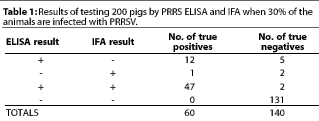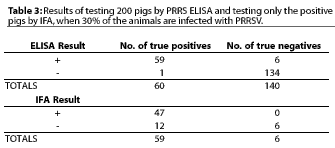
 |
 Cate Dewey
Cate Dewey
In the last issue, I discussed the impact of sensitivity and specificity on the validity of laboratory test results. Positive and negative predictive values were calculated for herds in which 80%, 30%, and 0% of the animals were serologically positive for PRRS.
We can alter the positive and negative predictive values if we conduct two different tests on the same animals. We may choose to do the second test only on animals that test positive on the first test, or we may wish to conduct the second test on all animals. We then interpret the laboratory tests in series or in parallel. In a series interpretation, the animal is considered positive only if it tests positive on both tests. In a parallel interpretation, the animal is considered positive if it tests positive on either test.
As an example, let's take 200 samples from a farm where 30% of the pigs have been infected with the PRRSV for at least 14 days. First, we will test all animals with both the indirect fluorescent antibody (IFA) test and the IDEXX ELISA (enzyme-linked immunosorbent assay). We will assume that the sensitivity of the IFA test is 80% and the specificity is 96%. For the ELISA test, we will assume that the sensitivity is 99% and the specificity is 96%. (Table 1)

We can assume that the tests will agree with one another 98% of the time. Therefore, of the 48 pigs that test positive on the IFA test, we expect that 47 will also test positive on the ELISA test. (Table 2)

Assuming that 47 animals tested positive to both tests, 12 more animals tested positive only to the ELISA, and one more animal tested positive only to the IFA test, the test has indicated that 60 animals tested positive to one or other of the tests (47 + 12 + 1 = 60). Parallel interpretation increases the sensitivity of the testing procedure. Therefore, we are more likely to correctly identify positive animals. This interpretation also decreases the positive predictive value. Only 87% of the positive animals are actually PRRS positive.
This is the safest way not to miss a potentially positive animal, but it will result in a higher false positive rate.
Forty-seven animals tested positive on both tests. Only these animals are considered positive in a series interpretation. Series interpretation increases the specificity of our testing procedure. This means we are more likely to correctly identify truly negative animals.
Series interpretation also increases the positive predictive value. We conclude that 96% of the test-positive animals actually are PRRS positive. This is a good interpretation to use when you wish to reduce the number of false positives. (Table 3)

The 65 animals that tested positive on the ELISA test were subsequently tested with the IFA. (Table 4) Using a series interpretation, the animals are considered positive only if they test positive on both tests. Therefore, only 47 animals would be considered positive. The series interpretation increases the ability to correctly identify negative animals. However, there will be some false negative results. The positive predictive value becomes 100%; therefore, all animals that test positive are indeed positive.

Unfortunately, serological tests are not independent. The ELISA and the IFA both measure antibodies. These tests are expected to provide the same results 98% of the time. The improvement in positive predictive value expected by using a series interpretation is not as great as it would be if the tests were independent of one another. An example of independent tests would be an ELISA test and virus isolation both conducted on the same animal.
Yoon K-J, Zimmerman J, Swenson SL, McGinley MJ, Eernisse KA, Brevik A, Rhinehart LL, Frey ML, Hill HT, Platt KB. Characterization of the humoral immune response to porcine reproductive and respiratory syndrome (PRRS) virus infection. J Vet Diagn Invest. 1995;7:305-312.
Cho H-J, McNab B, Dubuc C, Jordan L, Afshar A, Magar R, Prins S, Eernisse, K. Comparative study of serological methods for the detection of antibodies to Porcine Reproductive and Respiratory Syndrome Virus. Can J Vet Res. 1997;61:161-166.
 |










The AASV website and The Journal of Swine Health and Production are made possible by the generous support of the AASV Industry Support Council, including: .
Copyright (C) 1996-2002 American Association of Swine Veterinarians. Please send your suggestions about this site to Dave Brown, webmaster@aasv.org.
This page last updated April 19, 2012.